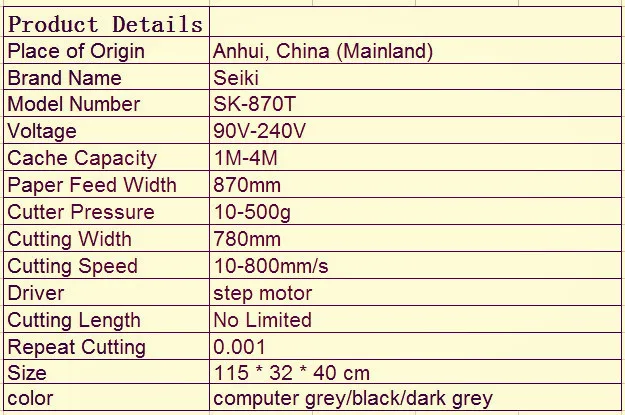

#Plotter seiki 34 vase software
VinylMaster Cut software is quite possibly the best vinyl cutting software on the market today.
#Plotter seiki 34 vase pdf
Check out a pdf list of all the included features here. Edit images, draw shapes, customize text, modify signs, create logos, and so much more. Fonts are vectorized and ready to cut immediately. Take your creative vision from your mind to ready to cut computer image file with an easily customizable and intuitive interface. VinylMaster Cut allows you to produce a wide range of vinyl lettering, pinstriping, and general signage, and comes with a suite of text, curve, and object tools. VinylMaster Cut (Basic Edition) is dedicated vinyl cutting software designed specifically for making vinyl signage.
#Plotter seiki 34 vase Pc
Included Software: VINYLMASTER CUT for PC ($59.99 value) Three fully adjustable pinch-rollers allow you to use a flexible range of materials.ĭual ball-bearing media roller system allows material to be placed on top of rollers rather than feeding through roll each time.

Standard blade holder gives you access to the most economical blades available.

round ( grid_x, 1 ) sample_range_y = np. arange ( start_range, end_range, digit_size ) sample_range_x = np.

figure ( figsize = ( figsize, figsize )) start_range = digit_size // 2 end_range = n * digit_size + start_range pixel_range = np. reshape ( digit_size, digit_size ) figure = digit plt. linspace ( - scale, scale, n ) for i, yi in enumerate ( grid_y ): for j, xi in enumerate ( grid_x ): z_sample = np. linspace ( - scale, scale, n ) grid_y = np. zeros (( digit_size * n, digit_size * n )) # linearly spaced coordinates corresponding to the 2D plot # of digit classes in the latent space grid_x = np. Import matplotlib.pyplot as plt def plot_latent_space ( vae, n = 30, figsize = 15 ): # display a n*n 2D manifold of digits digit_size = 28 scale = 1.0 figure = np. update_state ( reconstruction_loss ) self. reduce_sum ( kl_loss, axis = 1 )) total_loss = reconstruction_loss + kl_loss grads = tape. binary_crossentropy ( data, reconstruction ), axis = ( 1, 2 ) ) ) kl_loss = - 0.5 * ( 1 + z_log_var - tf. GradientTape () as tape : z_mean, z_log_var, z = self. Mean ( name = "kl_loss" ) def metrics ( self ): return def train_step ( self, data ): with tf. Mean ( name = "reconstruction_loss" ) self. Model ): def _init_ ( self, encoder, decoder, ** kwargs ): super ( VAE, self ). Sampling (Sampling) (None, 2) 0 z_meanĬonv2d_transpose (Conv2DTran (None, 14, 14, 64) 36928Ĭonv2d_transpose_1 (Conv2DTr (None, 28, 28, 32) 18464Ĭonv2d_transpose_2 (Conv2DTr (None, 28, 28, 1) 289ĭefine the VAE as a Model with a custom train_stepĬlass VAE ( keras. Layer (type) Output Shape Param # Connected to


 0 kommentar(er)
0 kommentar(er)
